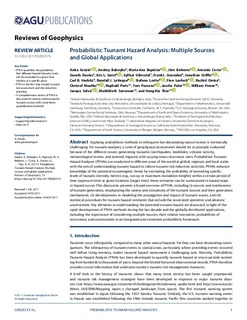| dc.contributor.author | Grezio, Anita | |
| dc.contributor.author | Babeyko, Andrey | |
| dc.contributor.author | Baptista, Maria Ana | |
| dc.contributor.author | Behrens, Jörn | |
| dc.contributor.author | Costa, Antonio | |
| dc.contributor.author | Davies, Gareth | |
| dc.contributor.author | Geist, Eric | |
| dc.contributor.author | Glimsdal, Sylfest | |
| dc.contributor.author | Gonzáles, Frank | |
| dc.contributor.author | Griffin, Jonathan | |
| dc.contributor.author | Harbitz, Carl Bonnevie | |
| dc.contributor.author | LeVeque, Randall J. | |
| dc.contributor.author | Lorito, Stefano | |
| dc.contributor.author | Løvholt, Finn | |
| dc.contributor.author | Omira, Rachid | |
| dc.contributor.author | Mueller, Christof | |
| dc.contributor.author | Paris, Raphaël | |
| dc.contributor.author | Parsons, Tom | |
| dc.contributor.author | Polet, Jascha | |
| dc.contributor.author | Power, William | |
| dc.contributor.author | Selva, Jacopo | |
| dc.contributor.author | Sørensen, Mathilde B. | |
| dc.contributor.author | Thio, Hong Kie | |
| dc.date.accessioned | 2018-11-22T09:47:08Z | |
| dc.date.available | 2018-11-22T09:47:08Z | |
| dc.date.created | 2017-12-08T08:20:06Z | |
| dc.date.issued | 2017 | |
| dc.identifier.citation | Reviews of geophysics. 2017, 55 (4), 1158-1198. | |
| dc.identifier.issn | 8755-1209 | |
| dc.identifier.uri | http://hdl.handle.net/11250/2574283 | |
| dc.description.abstract | Applying probabilistic methods to infrequent but devastating natural events is intrinsically challenging. For tsunami analyses, a suite of geophysical assessments should be in principle evaluated because of the different causes generating tsunamis (earthquakes, landslides, volcanic activity, meteorological events, asteroid impacts) with varying mean recurrence rates. Probabilistic Tsunami Hazard Analyses (PTHAs) are conducted in different areas of the world at global, regional, and local scales with the aim of understanding tsunami hazard to inform tsunami risk reduction activities. PTHAs enhance knowledge of the potential tsunamigenic threat by estimating the probability of exceeding specific levels of tsunami intensity metrics (e.g., runup or maximum inundation heights) within a certain period of time (exposure time) at given locations (target sites); these estimates can be summarized in hazard maps or hazard curves. This discussion presents a broad overview of PTHA, including: (i) sources and mechanisms of tsunami generation, emphasizing the variety and complexity of the tsunami sources and their generation mechanisms; (ii) developments in modeling the propagation and impact of tsunami waves; (iii) statistical procedures for tsunami hazard estimates that include the associated epistemic and aleatoric uncertainties. Key elements in understanding the potential tsunami hazard are discussed, in light of the rapid development of PTHA methods during the last decade and the globally distributed applications, including the importance of considering multiple sources, their relative intensities, probabilities of occurrence and uncertainties in an integrated and consistent probabilistic framework. | |
| dc.description.abstract | Probabilistic Tsunami Hazard Analysis (PTHA): multiple sources and global applications | |
| dc.language.iso | eng | |
| dc.title | Probabilistic Tsunami Hazard Analysis (PTHA): multiple sources and global applications | |
| dc.title.alternative | Probabilistic Tsunami Hazard Analysis (PTHA): multiple sources and global applications | |
| dc.type | Peer reviewed | |
| dc.type | Journal article | |
| dc.description.version | publishedVersion | |
| dc.source.pagenumber | 1158-1198 | |
| dc.source.volume | 55 | |
| dc.source.journal | Reviews of geophysics | |
| dc.source.issue | 4 | |
| dc.identifier.doi | 10.1002/2017RG000579 | |
| dc.identifier.cristin | 1524488 | |
| dc.relation.project | Norges forskningsråd: 231252 | |
| dc.relation.project | EU/603839 | |
| cristin.unitcode | 7452,3,3,0 | |
| cristin.unitcode | 7452,4,2,0 | |
| cristin.unitname | Risiko, Skredgeoteknikk og Klimatilpasning | |
| cristin.unitname | Computational Geomechanics (CGM) | |
| cristin.ispublished | true | |
| cristin.fulltext | original | |
| cristin.qualitycode | 2 | |
